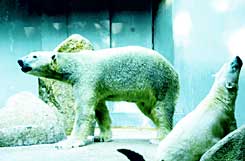Although polar bears' fur looks white, it is actually colorless: the fur hairs are hollow, and contain no color pigments. They can reflect visible light, similar to the way snow or ice reflects light, thus creating the illusion that the fur is white.

concentration of sources
Polar bears are known worldwide for their white fur color. This is perhaps the reason why whenever a bear is discovered whose fur color has changed, it immediately becomes the center of attention. Six months ago it was a polar bear in a zoo in Argentina whose fur turned purple - and now it's two polar bears in a zoo in Singapore whose fur has turned green.
Although polar bears' fur looks white, it is actually colorless: the fur hairs are hollow, and contain no color pigments. They can reflect visible light, similar to the way snow or ice reflects light, thus creating the illusion that the fur is white.
In the last few days, the color of two polar bears at the Singapore Zoo changed from white to green. It is about the bear "Shiva" and her 13-year-old offspring "Inuka". Rumors spread in the area that the bears had been sprayed with camouflage paint. However, the spokesperson for the zoo explained that the reason why the white bears turn green lies in the algae that grows inside the hollow hairs of the bear's fur, and compares them to the green color. Algae does not harm the bear's health, but it mainly indicates that the bear should not grow in a humid and hot area like Singapore. "The algae is not harmful," the spokesman for the zoo told the news agencies, "it grows in the hot and humid climate that exists in Singapore." The spokesperson added that the two bears are being treated, and in the near future they will be white again.
This is not the first time polar bears have turned green. The website Polar Bears International, dedicated to dealing with polar bears, says that in 1979 some bears at the San Diego Zoo in California changed their color to green.
In July 2003 the polar bear "Plosa" changed its color to purple. The color of the bear's fur, which lives in the zoo in the city of Mendoza in Argentina, about a thousand kilometers west of Buenos Aires, changed due to medical treatment given to it against skin inflammation. It turns out that the bear had an allergic reaction to the treatment, as a result of which the hairs in her fur turned purple. In a short time she became the focus of global attention and dozens of media teams came from all over the world to take a picture.
The polar bears are a species that split from the brown bears about 200 thousand years ago. They adapted to the harsh cold conditions and today they are considered the largest land carnivore on the planet. There are 25-22 thousand polar bears in the world. About 60% of them live in Canada and the rest in Alaska, Russia, Greenland, Norway and the North Pole. In the 60s and 70s, the bear population decreased and worldwide the fear that they would be in danger of extinction grew. Following this, a treaty was signed between the countries where the bears live, which made them a protected animal, but today there is still a danger to the existence of the polar bears due to global warming, which causes the melting of the large glaciers. Scientists have discovered that in the last 25 years there has been a 40% decrease in the thickness of the glaciers and 7% of the surface of the glaciers has melted. Polar bears live on hard surfaces of glaciers and without them they cannot hunt their prey - usually seals.
Although the polar bears at the Singapore Zoo have no intention of celebrating Purim, they still "dressed up": their white, beautiful and shiny fur recently turned green - because of a green, tropical algae that stuck to the fur. This strange "color change" happened with the bear and her 13-year-old son, Inoka, in their spacious cage at the Singapore Zoo, which is one of the most well-kept in the world.
The park workers called in biologists, who carefully examined the polar bears and discovered that green algae had settled in their hair, which continues to grow inside the fur.
In the hairs of the bear's fur are tiny air spaces into which algae has penetrated. "It's all because of the hot weather and the high tropical humidity that prevails in Singapore", explained the experts, and hastened to reassure that the bears' health was not harmed.
We will be blessed again
Despite the attraction, which attracts many visitors, there is an intention to return the color of the bears' fur in this zoo to its original, using chemical bleaching agents. For a few weeks, hydrogen peroxide will be sprayed on the green fur. According to the zoologists' recommendation, this treatment is given first to the mother bear, who will be monitored, before the treatment of her cub begins. So far the two bears have seemed quite indifferent to the color changes to green that have occurred to them. In the announcement of the spokesperson of the garden, it was stated that the green color, like that of light grass, appeared in spots that appeared behind the ears, on the back and on the legs. In some places on the body, the original white color still remains.

One response
Animal cruelty, really. If something works out for millions of years and everything is fine, why take risks and change the order of nature? In the end we will have orange bears in Israel, pink bears in Brazil and mouse-gray bears in Turkmenistan. What's good about it? Let's return them to nature and stop playing with animals, we'll leave the skin problems to humans, they have no choice but to deal with them...